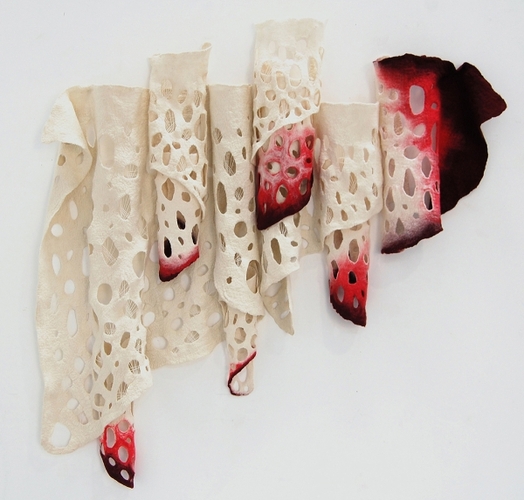BRATTLEBORO — Five exhibits will open at the Brattleboro Museum & Art Center (BMAC) on Saturday, June 18, including a group exhibit of art made from felt, a multimedia exhibit of Abenaki art, and solo exhibits by Mie Yim, Beth Galston, and Frank Jackson.
An opening party will take place that day at 5 p.m. to celebrate the new exhibits, as well as the outdoor exhibits “Roberley Bell: The Landscape Stares Back” and “Oasa DuVerney: Black Power Wave,” both of which opened on May 6.
Admission is free. Light appetizers and soft drinks will be served outdoors under a tent. Cocina Lupita will sell Salvadorian food (tacos, burritos, quesadillas, pupusas, pastelitos, and more) from their food truck, and Windham Wines will provide a cash bar.
The Bluebird Orchestra, with musicians Donald Saaf, Matthew Sharff, and Rick Contino, will perform original music that “explores the territory between Kurt Weill, Tom Waits, and The Incredible String Band.” Face coverings are required inside the museum during this event.
New exhibits opening Friday
• “Felt Experience,” curated by Sarah Freeman and Katherine Gass Stowe, surveys the work of five artists who use the medium of felt in diverse and novel ways: Marjolein Dallinga, Ruth Jeyaveeran, Melissa Joseph, Liam Lee, and Stephanie Metz.
“Felt is an ancient material, predating woven cloth,” Gass Stowe wrote in a statement accompanying the exhibit. “'Felt Experience' can refer to understanding something through touch, and also to the deeply emotional responses evoked in the body by an object or place. This exhibition showcases artists whose work can be said to encompass both perspectives.”
• “Nebizun: Water Is Life,” curated by Vera Longtoe Sheehan, features artwork by Abenaki artists of the Champlain Valley and Connecticut River Valley regions, including protest art created in support of the Native American Water Protectors, who opposed the construction of the Dakota Access Pipeline.
A special opening celebration for “Nebizun,” featuring a curator talk by Longtoe Sheehan and performances by Abenaki musicians will be held on Friday, June 24, at 7 p.m. This exhibit is presented in partnership with the Vermont Abenaki Artists Association and the Abenaki Arts & Education Center.
“As stewards of the environment, Native American people know the importance of clean water,” Longtoe Sheehan said. “We understand the healing powers of water. The Abenaki people know how essential water is to foodways, medicine, and everyday activities that may be taken for granted.”
• Mie Yim, the New York–based artist featured in “Fluid Boundaries,” describes her paintings this way: “Sugary colors and anthropomorphic shapes conjure bunny ears or doe eyes, and forms like spikes, polyps, and vegetal structures take the coronavirus as an inspiration. The chaos and horror of nature will always be in tandem with beauty and wonder in my paintings.”
Freeman, who is BMAC's director of exhibitions and curated the exhibit, said, “Yim renders her intriguing and unsettling creatures in vivid, saturated color that draws the eye, while the mark-making varies from thick and cakey to rough, scratchy, and frenzied, creating an uneasy tension. Yim's ability and willingness to explore the porous boundaries between figuration and abstraction result in a body of work that compels you to look closer but leaves you uncertain and off balance.”
• At the beginning of the pandemic, artist Beth Galston and several other alumni of a graduate program at MIT's Center for Advanced Visual Studies created videos in the silos of the Goldring-Piene Art Farm in Groton, Massachusetts, which they found were an ideal setting for socially distanced art making. Galston's video became part of her new BMAC installation “Unraveling Oculus.”
“I created my video in the Bell Silo, which contains a suspended bell and benches created by artist Paul Matisse,” Galston said. “Using mirrors to reflect the silo's oculus, as well as natural materials collected on my daily walks in the woods, I created a series of actions as a kind of 'duet' with the deep resonant sounds and changing light in the silo.” Galston made the video in collaboration with Ellen Sebring.
In Galston's BMAC installation, which was curated by Mara Williams, the video is paired with sculptural elements, including mirrors and tens of thousands of acorn caps. “My goal is to choreograph the elements of light, space, nature, and material into immersive environments, engaging viewers as participants in an imaginative journey,” Galston said.
• “There/There” is an exhibit of abstract landscape fresco paintings by Frank Jackson which address questions of place, memory, and experience.
In an essay accompanying the exhibit, Jackson explains, “During the brief passage of time [in the process of creating a fresco painting] that the intonaco layer of lime accepts pigments and image, surfaces move from wet to dry, color is buried and hardened, and transparency and opacity locate moments of the day. There's an urgency to the technique of fresco painting, and the possibility and limitations work off each other.”
Artist talks, events will complement exhibits
BMAC will present numerous in-person and virtual events while the new exhibits are on view, all on Thursdays, including talks by Katherine Gass Stowe (July 21), Mie Yim (Aug. 4), and Beth Galston and Mara Williams (Sept. 22).
Frank Jackson will present a workshop on making transfer prints (Saturday, July 23). Chef Jessee Lawyer will offer an online Abenaki cooking demonstration (Thursday, Aug. 11).
